The Surtees Racing Organisation was a race team that spent nine seasons as a constructor in Formula One, Formula 2, and Formula 5000.
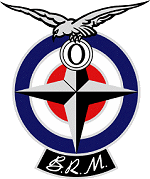
British Racing Motors (BRM) was a British Formula One motor racing team. Founded in 1945 and based in the market town of Bourne in Lincolnshire, it participated from 1951 to 1977, competing in 197 grands prix and winning seventeen. BRM won the constructors' title in 1962 when its driver Graham Hill became world champion. In 1963, 1964, 1965 and 1971, BRM came second in the constructors' competition.
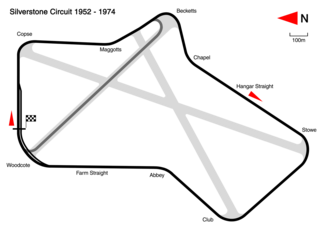
The 1973 British Grand Prix was a Formula One motor race held at Silverstone on 14 July 1973. It was race 9 of 15 in both the 1973 World Championship of Drivers and the 1973 International Cup for Formula One Manufacturers.

The 1971 Formula One season was the 25th season of the Fédération Internationale de l'Automobile's Formula One motor racing. It featured the 22nd World Championship of Drivers and the 14th International Cup for F1 Manufacturers which were contested concurrently over eleven races between 6 March and 3 October. The season also included a number of non-championship races open to Formula One cars.

The 1968 Formula One season was the 22nd season of the FIA's Formula One motor racing. It featured the 19th FIA World Championship, which commenced on 1 January, and ended on 3 November after twelve races, and numerous non-championship races. Graham Hill won the second of his World Championship titles, with Lotus.

Keith Jack Oliver is a British former Formula One driver and team-owner from England. He became known as the founder of the Arrows team as well as a racing driver, although during his driving career he won both the 24 Hours of Le Mans race and the Can-Am championship. Oliver was also the second person to complete the informal triple Crown of endurance racing.
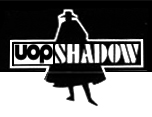
Shadow Racing Cars was a Formula One and sports car racing team, founded and initially based in the United States although later Formula One operations were run from the British base in Northampton. The team held an American licence from 1973 to 1975 and a British licence from 1976 to 1980, thus becoming the first constructor to officially change its nationality. Their only F1 victory, at the 1977 Austrian Grand Prix, was achieved as a British team.
Embassy Racing With Graham Hill, commonly abbreviated to Embassy Hill, was a short-lived Formula One team started by two-time Formula One World Champion Graham Hill. The team debuted in 1973 with a customer Shadow DN1 car, and began racing as a constructor with its own chassis in 1975. The team had limited success in three seasons of racing, but everything was cut short by the death of Hill, Tony Brise and some of the team's top personnel in the crash of a light aircraft in the autumn before the 1976 season. The team was sponsored by Imperial Tobacco's Embassy cigarette brand and ran under various names during its time.

The Lotus 49 was a Formula One racing car designed by Colin Chapman and Maurice Philippe for the 1967 F1 season. It was designed around the Cosworth DFV engine that would power most of the Formula One grid through the 1970s. It was one of the first F1 cars to use a stressed member engine combined with a monocoque to reduce weight, with other teams adopting the concept after its success. It also pioneered the use of aerofoils to generate downforce.

The Arrows A2 was a Formula One racing car, designed by Tony Southgate and Dave Wass, was used by the Arrows team in the latter half of the 1979 Formula One season. Powered by a Cosworth DFV V8 engine and driven by Riccardo Patrese and Jochen Mass, it was relatively unsuccessful with its best finish being sixth on two occasions.
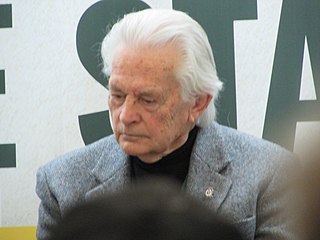
Tony Southgate is a British engineer and former racing car designer. He designed many successful cars, including Jaguar's Le Mans-winning XJR-9, and cars for almost every type of circuit racing. He was responsible for the chassis design of Ford's RS200 Group B rally car. Southgate was employed as chief designer or technical director for many Formula One teams for over twenty years. These teams included BRM, Shadow and Arrows. Southgate retired after producing the Audi R8C, which was a major influence in the Bentley Speed 8, which won Le Mans in 2003. He continues to be a regular visitor to current and historic race meetings.

The Shadow DN3 was a Formula One car used by the Shadow team during the 1974 Formula One season. It also appeared twice during the early stages of the 1975 Formula One season in an updated DN3B form. Designed by former BRM engineer Tony Southgate, the best finish achieved in a DN3 was Jean-Pierre Jarier's third place at the Monaco Grand Prix.
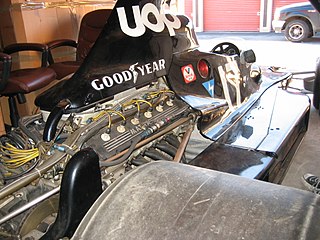
The Shadow DN7 was a Formula One car used by the Shadow team in two races late in the 1975 Formula One season. Driven by Jean-Pierre Jarier, it never finished a race.

The Shadow DN5 was a Formula One car used by the Shadow team during the 1975 Formula One season. Updated to a 'B' specification, it was used through the 1976 Formula One season and for the first two races of the following season. It was qualified on pole position three times, and twice achieved a fastest lap in a race. Its best finish in a race was third (twice), both times driven by Tom Pryce.
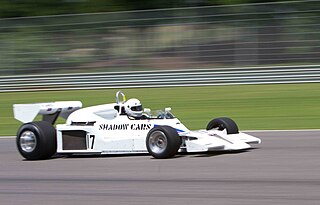
The Shadow DN8 was a Formula One car used by the Shadow team during the 1976, 1977 and 1978 Formula One seasons. Driven by Alan Jones, it won the 1977 Austrian Grand Prix, Shadow's only Grand Prix victory.

The BRM P48 was a Formula One racing car raced in 1960. It was BRM's first rear-engined car. With rear-engined cars in the ascendancy, BRM hastily reworked the front-engined, now five-year-old P25. The car proved to be slow and unreliable, and was replaced by the P48/57 the following year.

The BRM P57 was a Formula One racing car built to race in Formula One from 1962 to 1965.
Don Nichols was the founder and former principal of the Shadow CanAm and Formula One racing team.
Michael Roy Pilbeam is a British motorsport designer and engineer known for his work with BRM, Lotus, Surtees and his own company, Pilbeam Racing Designs. An early design was the experimental four wheel drive Formula One BRM P67 of 1964. As of 2014, Pilbeam's company continued to produce hillclimb cars and sports prototype chassis for endurance racing.

The Shadow DN9 was a Formula One car used by the Shadow team during the 1978 and 1979 Formula One seasons. It is most famous for having been copied by the new Arrows team for their FA1. Arrows, formed by a disgruntled group of Shadow's staffers, were in the end prohibited from using the design.


















